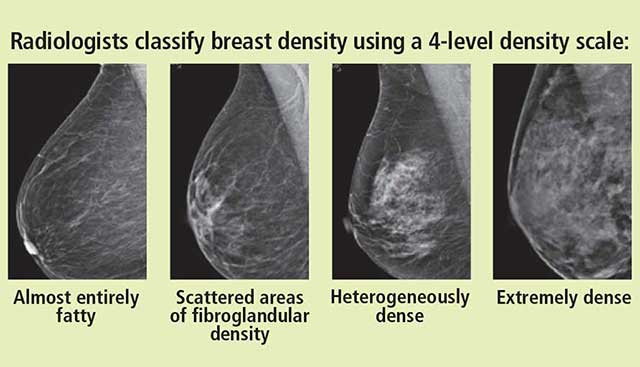
What Does It Mean to Have Dense Breasts?
If, after having a mammogram, you were told by your physician that you have dense breasts, you might wonder exactly what that means. Dense breasts are very common and not necessarily a cause for concern. Breast density is simply a measure of the amount of non-fatty tissue in relation to the amount of fatty tissue within a breast. In general, dense breasts have more supportive tissue (stroma) and glandular tissue, which produces and drains milk, than non-dense breasts.
In the images produced by a mammogram, fatty breast tissue shows up as a darker area, while dense tissue and cancerous tissue both appear white. Therefore, the significance of dense breast tissue is that it can sometimes hide breast masses in a mammogram, making the cancer more difficult to see.
Breast density is not determined by how a breast feels to the touch, either during a self-exam or a clinical exam performed by a physician. Rather, it is evaluated on a mammogram. One common assessment of breast density is outlined by the Breast Imaging Reporting and Database Systems (BI-RADS), which is used to report the results of mammograms. Specifically, BI-RADS classifies breast density into the following four categories:
- Almost entirely fatty – A breast is composed mostly of fat, with relatively little fibrous and glandular tissue. This means that any abnormalities would likely show up well in a mammogram.
- Scattered density – A breast has a fair amount of fat with a few areas of fibrous and glandular tissue.
- Heterogeneously dense – A breast has more fibrous and glandular tissue. This can make it more difficult for a radiologist to detect cancerous changes in a mammogram.
- Extremely dense – A breast has a high amount of fibrous and glandular tissue. Because breast masses can sometimes blend in with dense, healthy tissue in a mammogram, cancer can be more difficult for a radiologist to see.
If you have dense breasts (and even if you don’t), certain lifestyle habits can help you lower your breast cancer risk. These include maintaining a healthy weight, exercising regularly, limiting your consumption of alcoholic beverages, eating a nutritious diet and not smoking. In addition to making any necessary lifestyle changes, you may be advised by your physician to have more frequent cancer screenings and additional tests, such as breast ultrasounds or MRIs.
To be most effective, breast cancer screening tests must be performed on a regular basis (at the frequency recommended by a physician). It is also essential for a radiologist to compare the information obtained from past results, so always bring prior mammograms and reports with you when you transfer your care to another facility. For added peace of mind, you might request a copy of each of your breast imaging reports and keep all of this information together in a folder or binder.
If you have questions about breast density or breast cancer screening tests, the experts at Moffitt Cancer Center can recommend an appropriate plan for you. To get started, call 1-888-663-3488 or complete our new patient registration form online. No referrals are necessary.
